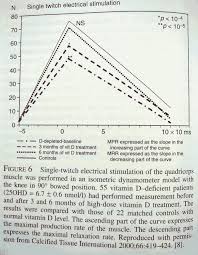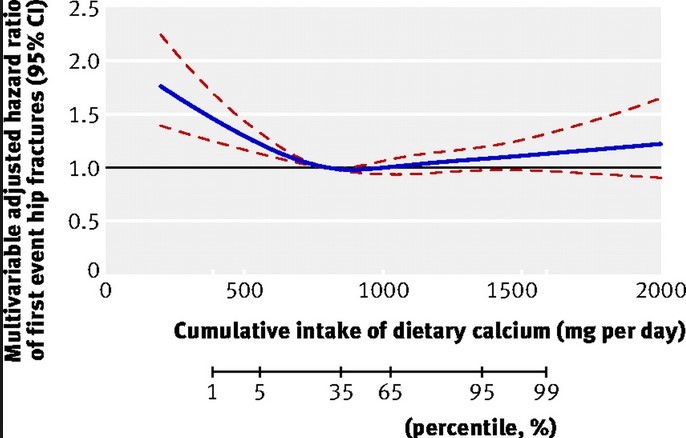Overview Fractures and Falls and Vitamin D
It appears that at least 2,000 IU of vitamin D and 500 mg of Calcium are needed to substantially reduce falling
It appears that as little as 800 IU of vitamin D without any Calcium will reduce falling
See falling at Vitamin D Life
All items in category Falls or Fractures and Vitamin D items
Rate of falls reduced 2X by just 1000 IU of vitamin D – RCT Nov 2015
800 IU of vitamin D does not prevent falls (nope, need at least 2,000) - March 2015
Hip bone loss stopped with 1000 IU of vitamin D, while 400 IU similar to placebo – RCT April 2013
Seniors with less than 12 ng of vitamin D were not stable – March 2012
Just 700 IU of vitamin D and 700 mg of Calcium reduces falls and fractures – Nov 2010
Fewer falls and fractures as vitamin D is increased – 1800 to 4000 IU July 2010 sorts the results by IU
1000 IU minimum to decrease falls and fractures Swiss - 2009
Vitamin D and Calcium best to prevent falls – RCT 2009 800 IU vitamin D and 1000 mg Calcium
Vitamin D One of Few Things that Help Prevent Falls – Cochraine Jan 2010
- Interventions for preventing falls in older people in care facilities and hospitals Cochrane update Dec 2012
- In care facilities, vitamin D supplementation is effective in reducing the rate of falls. (reduced rate of falls by 36%)
Meta-analysis of falls and 800+ IU of vitamin D found good results – June 2010
Vitamin D in high doses prevents falls Essential Evidence Dec 2009
More muscle response when have adequate vitamin D
- Adequate Vitamin D levels should provide stronger and faster reaction to falling
Seniors with more than 30ng of vitamin D walked better – May 2011
Cochrane review finds that Vitamin D prevents falls in nursing homes – downloaded Feb 2010
“Sunlight Officers” in some Australian senior facilities – Sept 2011
Risk of falls minimized with just 24 ng of vitamin D – June 2011
Falls of elderly whites increasing 5 percent per year – Jan 2012 far fewer falls for blacks
Vitamin D reduces falls and fractures for some – April 2012
Papers which are meta-analysis of Falls/Fractures and Vitamin D in Vitamin D Life are
{category}
20 Most-visited pages in Fractures & Falls category in Vitamin D Life
{LISTPAGES}
See fractures at Vitamin D Life
Would there be fewer stress and bone fractures with vitamin D
Causes, consequences, and treatment of osteoporosis in men– Aug 2013
CLICK HERE for all items of Rheumatoid Arthritis at Vitamin D Life - items
CLICK HERE for all items Bone – Osteoporosis at Vitamin D Life - items
CLICK HERE for all items Bone Health at Vitamin D Life- items
Following paper range of vitamin D considered was from 66 IU to 1000 IU, with Median of 800 IU
Only 6 of their studies added Calcium to the vitamin D
Primary Care–Relevant Interventions to Prevent Falling in Older Adults:
A Systematic Evidence Review for the U.S. Preventive Services Task Force - Dec 2010
Yvonne L. Michael, ScD, SM; 2. Evelyn P. Whitlock, MD, MPH; 3. Jennifer S. Lin, MD, MCR; 4. Rongwei Fu, PhD;
Elizabeth A. O'Connor, PhD; and 6. Rachel Gold, PhD, MPH
From Drexel University School of Public Health, Philadelphia, Pennsylvania, and Kaiser Permanente Center for Health Research and Oregon Health & Science University, Portland, Oregon.
Background: Falls among older adults are both prevalent and preventable.
Purpose: To describe the benefits and harms of interventions that could be used by primary care practitioners to prevent falling among community-dwelling older adults.
Data Sources: The reviewers evaluated trials from a good-quality systematic review published in 2003 and searched MEDLINE, the Cochrane Central Register of Controlled Trials, Cochrane Database of Systematic Reviews, and CINAHL from the end of that review's search date to February 2010 to identify additional English-language trials.
Study Selection: Two reviewers independently screened 3423 abstracts and 638 articles to identify randomized, controlled trials (RCTs) of primary care–relevant interventions among community-dwelling older adults that reported falls or fallers as an outcome. Trials were independently critically appraised to include only good- or fair-quality trials; discrepancies were resolved by a third reviewer.
Data Extraction: One reviewer abstracted data from 61 articles into standardized evidence tables that were verified by a second reviewer.
Data Synthesis: Overall, the included evidence was of fair quality.
In 16 RCTs evaluating exercise or physical therapy, interventions reduced falling (risk ratio, 0.87 [95% CI, 0.81 to 0.94]).
In 9 RCTs of vitamin D supplementation, interventions reduced falling (risk ratio, 0.83 [CI, 0.77 to 0.89]).
In 19 trials involving multifactorial assessment and management, interventions with comprehensive management seemed to reduce falling, although overall pooled estimates were not statistically significant (risk ratio, 0.94 [CI, 0.87 to 1.02]). Limited evidence suggested that serious clinical harms were no more common for older adults in intervention groups than for those in control groups.
Limitations: Interventions and methods of fall ascertainment were heterogeneous. Data on potential harms of interventions were scant and often not reported.
Conclusion: Primary care–relevant interventions exist that can reduce falling among community-dwelling older adults.
Primary Funding Source: Agency for Healthcare Research and Quality.
[tiki-download_file.php?fileId=1627]
Average of all levels of Vitamin D decreased falls by 17%
Imagine how much decrease there would have been with 4,000 IU, as reported in other papers above
8% of hospitalisations for falls and hip fractures in Australia were attributable to vitamin D deficiency (<20 ng)
Hospitalisations for falls and hip fractures attributable to vitamin D deficiency in older Australians - Jan 2021
doi: 10.1017/S0007114521000416
It has been known since year 2000 that nerve conduction velocity speeds up with increased vitamin D - see following graph

Juvent Micro-Impact Platform - $3,500 - Nov 2017
Computer and software find the resonant frequency of the user in a safe range of frequencies (32Hz-37Hz) and therefore is able to use a very small level of energy (.3g) to deliver a physiologically effective energy pulse.
"Simply standing on the Juvent Platform for 10 to 20 minutes a day. You’ll feel a subtle, pleasant stimulation. Starting at your feet and legs, it extends upward through your torso, arms, and upper body. Using our platform just three days a week has been shown to help improve blood flow, ease joint, knee and back pain, and increase stability."
---
Vitamin D supplementation and falls: a trial sequential meta-analysis July 2014
did NOT find that vitamin D affected rate of falls.
All of the detail is behind a $28 paywall, so it is impossible to understand the conclusion.
Suspect that a majority of the trials considered used
Small doses of vitamin D
Small time intervals.
No or little Calcium
1 gram more of Calcium increases Hip Fracture risk by 30%
- full text free online. the phrase 'vitamin D" occurs 25 times

Vitamin D: a review on its effects on muscle strength, the risk of fall, and frailty - 2015
📄 Download the PDF from Vitamin D Life
Vitamin D Supplementation for the Prevention of Falls and Fractures in Residents in Long-Term Care Facilities: A Review of the Clinical Effectiveness, Cost-Effectiveness, or Guidelines - 2016
Meta-analysis from Canada with mixed results
Many of the studies used just 800 IU of vitamin D, so not much can be expected
📄 Download the PDF from Vitamin D Life
Great 5 minute video about Vitamin D for seniors - reduce falls, etc - March 2017
https://nutritionfacts.org/video/should-vitamin-d-supplements-be-taken-to-prevent-falls/
